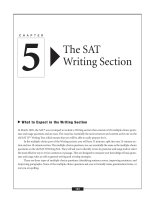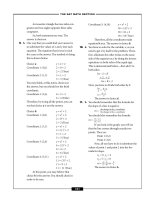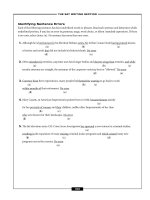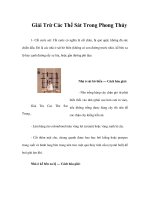The sat math section 4 pps
Bạn đang xem bản rút gọn của tài liệu. Xem và tải ngay bản đầy đủ của tài liệu tại đây (91.94 KB, 6 trang )
39. Marguerite is remodeling her bathroom floor.
Each imported tile measures 1
ᎏ
2
7
ᎏ
inch by 1
ᎏ
4
5
ᎏ
inch.
What is the area of each tile?
a. 1
ᎏ
3
8
5
ᎏ
square inches
b. 1
ᎏ
1
3
1
5
ᎏ
square inches
c. 2
ᎏ
1
3
1
5
ᎏ
square inches
d. 3
ᎏ
3
3
5
ᎏ
square inches
e. 4
ᎏ
3
1
2
ᎏ
square inches
40. If Deirdre walks from Point A to Point B to Point
C at a constant rate of 2 mph without stopping,
what is the total time she takes?
a. (x + y) × 2
b. 2x + 2y
c. xy Ϭ 2
d. (x + y) Ϭ 2
e. xy
2
A
BC
x miles y miles
–THE SAT MATH SECTION–
157
5658 SAT2006[04](fin).qx 11/21/05 6:44 PM Page 157
Five-Choice Answers
1. c. After reading the problem, you realize that
the amount of robins at the feeder is related
to the number of cardinals. When this is the
case, you have to set up a legend or a key
defining the number of cardinals. Then,
relate it to the number of robins.
Step 1: Let x = number of cardinals
Let 3x = number of robins
Step 2: Now, you have to come up with a for-
mula to solve for x.
(number of cardinals) + (number of robins)
= total number of birds
x + 3x = 20
4x = 20
x = 5
Step 3: Take your answer for x and substitute
it back into the legend.
x = number of cardinals
3x = number of robins
5 = number of cardinals
3(5) = number of robins
15 = number of robins
The answer is choice c.
2. b. You should realize that since the question
asks for a factor of 4x
2
– 9, you have to begin
factoring this expression.
The question you should ask yourself
is: Which method of factoring should I use?
Looking at the expression 4x
2
– 9, you
should notice that there are no common fac-
tors between the two terms. Therefore, you
cannot factor out a common factor.
Also, this is not a trinomial. Thus, you
cannot factor this expression like a trinomial.
The method that you have to use in fac-
toring is the difference of two perfect squares.
There are a couple of hints in the prob-
lem that clue you in on this.
First, there are only two terms.
Second, the operation between the two
terms is subtraction. Remember, the word
difference means subtraction.
Now, we have to factor 4x
2
– 9.
4x
2
– 9 = (2x + 3) (2x – 3)
This is now factored and we can see
that one of the factors is choice b,(2x + 3).
The answer is choice b.
3. a. The first thing you should remember is that
the sum of the angles of a triangle equals 180°.
m∠A + m∠B + m∠C = 180°
Now, you can substitute the values of
each angle into the formula and solve for y.
Step 1: 90 + y + 40 + 3y – 10 = 180
Step 2: 4y + 120 = 180
– 120 – 120
Step 3:
ᎏ
4
4
y
ᎏ
=
ᎏ
6
4
0
ᎏ
Step 4: y = 15
Next, you have to substitute the y value
back into your angle measure in order to find
out the degree measure of each angle.
m∠A = 90
m∠B = y + 40
= (15) + 40
= 55
m∠C = 3y – 10
= 3(15) – 10
=35
The three angle measures are 90, 55,
and 35, respectively, and their sum is 180.
Finally, you have to look at your answer
choices and determine what type of right tri-
angle this is.
Choice a is scalene. You remember that
a scalene right triangle is a right triangle that
has three sides of different length and three
angles of different measure. The triangle in
your problem fits this definition, but check
the other three choices before you settle on
choice a.
–THE SAT MATH SECTION–
158
5658 SAT2006[04](fin).qx 11/21/05 6:44 PM Page 158
Choice b is isosceles. An isosceles right
triangle has two base angles that are equal.
This is not the correct answer.
Choice c is equilateral. This is not an
equilateral triangle since the three angles are
not equal.
Choice d is obtuse. An obtuse right tri-
angle cannot exist since the angles of a trian-
gle add up to 180°. An obtuse angle is
between 90° and 180°, and if you add this to
a right angle, you have a sum over 180°.
Therefore, choice d is incorrect.
The answer is choice a.
4. d. Remember, when multiplying radical expres-
sions, multiply terms outside the radical
together and multiply terms inside the radical
together. The formula is demonstrated below.
a͙b
ෆ
× c͙d
ෆ
= (a × c)͙b
ෆ
× ͙d
ෆ
Therefore, (͙x
ෆ
)(͙2x
ෆ
) = ͙x × 2x
ෆ
= ͙2x
2
ෆ
Of course, you remember that x × 2x =
2x
2
because when multiplying terms with
like bases, you add the exponents.
This is your answer, ͙2x
2
ෆ
;however,it
is not one of the choices. Therefore, you
must reduce this expression to simplest form
in order to match your answer to one of the
choices.
Remember, you can break a radical
down into separate terms:
͙2x
2
ෆ
= ͙2
ෆ
× ͙x
2
ෆ
͙2
ෆ
cannot be simplified, but ͙x
2
ෆ
can
be simplified to x.
͙2
ෆ
× ͙x
2
ෆ
= ͙2
ෆ
× x
= ͙2x
ෆ
This answer is not listed as one of the
four choices. Yet, x͙2
ෆ
is choice d. Multipli-
cation is commutative, so ͙2
ෆ
(x) = x͙2
ෆ
.
Important: Many times, the answer that
you calculate will not be one of the answers
listed in a multiple-choice problem. Trust
your work if you have done it correctly. You
may have to manipulate your answer or sim-
plify it so that it matches one of the answers.
The answer is choice d.
5. c. This involves multiple probabilities. The first
thing you should try to figure out is what
you are trying to find.
The spinning of the spinner is an inde-
pendent event each time. This means that
the outcome on the first trial does not influ-
ence the outcome of the second trial.
Now, you must figure out the probabili-
ties of each event. When trying to figure out
the probabilities of multiple events, a tree
diagram is most helpful. This is shown below.
The first two branches represent the
first event, G or not G. The second set of
branches represents what can happen on the
second spin of the spinner, B or not B.
You are interested in the events of the
top branch, G then B.
These probabilities are P(G then B) =
ᎏ
1
4
ᎏ
×
ᎏ
1
2
ᎏ
=
ᎏ
1
8
ᎏ
.
You can calculate the P(G) by noticing
that G is
ᎏ
1
4
ᎏ
of the circle. Likewise, you can
find the P(B) by noticing B is
ᎏ
1
2
ᎏ
of the circle.
Since you want the event (G then B), you
multiply the probabilities to get
ᎏ
1
8
ᎏ
.
You can also find the probabilities of G
and B, respectively, by subdividing area B into
two sections as shown on the following page.
G
B
~B
B
~B
~G
–THE SAT MATH SECTION–
159
5658 SAT2006[04](fin).qx 11/21/05 6:44 PM Page 159
The P(G) =
ᎏ
1
4
ᎏ
.
However, P(B) =
ᎏ
2
4
ᎏ
.
If you do the problem this way, you will find
that:
P(G then B) = P(G) × P(B).
ᎏ
1
4
ᎏ
×
ᎏ
2
4
ᎏ
=
ᎏ
1
2
6
ᎏ
or
ᎏ
1
8
ᎏ
.
The answer is choice c.
6. d. Method 1: There are two different ways you
can approach this problem. The first way is
to identify the four choices and see which
one looks like a mathematical property that
you remember. If you can do this, you will
clearly see that choice d is the commutative
property and this is always true. If you can’t
remember or don’t see that choice d is the
commutative property, don’t worry. You can
always solve the problem another way.
Method 2: You can solve this problem by sub-
stituting values in for a and b. Then, see which
answer choice is true. Let’s see how this works:
Let a and b equal 2 and 3, respectively.
Choice a:
ᎏ
2
3
ᎏ
≠
ᎏ
3
2
ᎏ
Choice b: 2 + 2(3) = 3 + 2(2)
2 + 5 = 3 + 4
7 = 7
This looks like this answer choice might
be true. You should try two different values
just to be sure.
Let a and b equal 1 and 2, respectively.
1 + 2(2) = 2 + 2(1)
1 + 4 ≠ 2 + 2
5 ≠ 4
So, by double-checking your choice,
you can see that choice b is not true.
Choice c: 2 – 3 × 3 – 2
Therefore, choice c is false.
Now, you know that choice d must be
the answer. You should check it to be sure.
Choice d: 2 + 3 = 3 + 2 1 + 2 = 2 + 1
5 = 5 3 = 3
Therefore, the answer is choice d.
7. a. The first thing that you have to realize is that
the question requires you to simplify the
expression.
If you are simplifying rational expres-
sions (rational expressions look like frac-
tions), you have to factor the numerator and
denominator if possible.
Step 1: Factor the numerator, x
2
+ 2x.
There is a common factor of x between
the two terms.
Then, factor out an x and place it out-
side a pair of parentheses.
Then, divide x
2
and 2x, respectively, by
x in order to find out what terms are on the
inside of the parentheses.
So, x
2
+ 2x becomes x(x + 2).
Step 2: The denominator cannot be fac-
tored. Therefore, you can now cancel out
the like terms between the numerator and
denominator.
ᎏ
x(x
x
+2)
ᎏ
= (x + 2)
The answer is choice a.
8. a. You should recognize this first statement.
Think to yourself: Is there a triangle
that has two sides congruent and, thus, two
angles opposite the sides congruent?
The answer is yes. It is an isosceles
triangle.
Now, look at the converse statement.
If two angles are congruent in a trian-
gle, are the sides opposite these angles also
congruent?
The answer is yes.
–THE SAT MATH SECTION–
160
5658 SAT2006[04](fin).qx 11/21/05 6:44 PM Page 160
An isosceles triangle has two sides con-
gruent and two angles opposite these sides
congruent.
So, both statements are true. The
answer is choice a.
9. b. One way that you could find your answer is
to substitute the values of x and y into each
equation. The equation that is true in each
five cases is the answer. The method of doing
this is shown below.
Choice a: y = x + 2
Coordinate 1: (0,2) 2 = 0 + 2
2 = 2 (True)
Coordinate 2: (1,3) 3 = 1 + 2
3 = 3 (True)
You may think, at this point, choice a is
the answer, but you should try the third
coordinate.
Coordinate 3: (2,6) 6 = 2 + 2
6 = 4 (False)
Therefore, by trying all the points, you can
see that choice a is not the answer.
Choice b: y = x
2
+ 2
Coordinate 1: (0,2) y = x
2
+ 2
2 = 0
2
+ 2
2 = 2 (True)
Coordinate 2: (1,3) y = x
2
+ 2
3 = (1)
2
+ 2
3 = 1 + 2
3 = 3 (True)
Coordinate 3: (2,6) y = x
2
+ 2
6 = (2)
2
+ 2
6 = 4 + 2
6 = 6 (True)
Coordinate 4: (3,11) y = x
2
+ 2
11 = (3)
2
+ 2
11 = 9 + 2
11 = 11 (True)
At this point, you may believe that
choice b is the answer. You should check in
order to be sure.
Coordinate 5: (4,18) y = x
2
+ 2
18 = (4)
2
+ 2
18 = 16 + 2
18 = 18 (True)
Therefore, all the coordinates make
equation b true. The answer is choice b.
10. d. You have to solve for the variable, x, so you
need to get x by itself in the problem. There-
fore, eliminate the other terms on the same
side of the equation as x by doing the inverse
operation on both sides of the equal sign.
This is demonstrated below—first add 2 to
both sides:
bx – 2 = K
+ 2 + 2
bx = K + 2
Next, you have to divide both sides by b.
ᎏ
b
b
x
ᎏ
=
ᎏ
K
b
+2
ᎏ
x =
ᎏ
K
b
+2
ᎏ
The answer is choice d.
11. b. You should remember that the formula for
the slope of a line is equal to:
m =
You should also remember the formula
m =
If you look at the graph, you will see
that the line crosses through exactly two
points. They are:
Point 1 (0,2)
Point 2 (3,0)
Now, all you have to do is substitute the
values of point 1 and point 2 into the for-
mula for slope.
x
1
= 0 y
1
= 2
x
2
= 3 y
2
= 0
m =
ᎏ
(
(
0
3
–
–
2
0
)
)
ᎏ
or –
ᎏ
2
3
ᎏ
The answer is choice b.
(y
2
– y
1
)
ᎏ
(x
2
– x
1
)
the change in the y-coordinate
ᎏᎏᎏᎏ
the change in the x-coordinate
–THE SAT MATH SECTION–
161
5658 SAT2006[04](fin).qx 11/21/05 6:44 PM Page 161
12. a. This problem is difficult if you make it diffi-
cult, but it’s easy if you make it easy. The eas-
iest way to do this problem is to calculate the
mean, median, and mode for the data set.
Remember:
■
The mean is the same as the average.
■
The median is the middle number of
data. First, you must order the num-
bers from least to greatest.
■
The mode is the most frequently
occurring number.
So, the mean equals:
ᎏ
5+7+6
5
+5+7
ᎏ
= 6
The median, if found by rearranging
the numbers in the data set as shown, is {5, 5,
6, 7, 7}. Therefore, the median is 6.
The mode is the most frequently occur-
ring number. In this data set, there are two
numbers that appear most frequently: {5, 7}.
Now, inspect the answers.
You will quickly see that choice a is cor-
rect: The mean = median, because 6 = 6.
13. c. You have to figure out if XY
and YZ
are per-
pendicular. The key thing to remember here is
that perpendicular lines intersect to form right
angles. If you can find a right angle at the
point that XY
and YZ
intersect, then you know
that the two segments are perpendicular.
In Figure 1, if XY
and YZ
are perpendi-
cular, then ΔXYZ is a right triangle because it
contains a right angle at Y.
In ΔXYZ, you are given three sides. If
ΔXYZ is a right triangle, then the Pythago-
rean theorem should hold true for these
three sides.
(Leg 1)
2
+ (Leg 2)
2
= (Hypotenuse)
2
(6)
2
+ (8)
2
= (10)
2
Note: 10 is the hypotenuse because it is
across from the largest angle of the triangle.
36 + 64 = 100
100 = 100
ΔXYZ is a right triangle and, likewise,
X
ෆ
Y
ෆ
is perpendicular to YZ
because the
Pythagorean theorem is true for Figure 1.
In Figure 2, you are given the two
angles of ΔXYZ. If a third angle measures
90°, then ∠Y is a right triangle. Thus, X
ෆ
Y
ෆ
is
perpendicular to Y
ෆ
Z
ෆ
.
m∠X + m∠Y + m∠Z = 180°, since
the sum of the angles of a triangle = 180.
25° + x + 65° = 180°
90° + x = 180°
Therefore, x = 90°. ∠Y is a right angle
and X
ෆ
Y
ෆ
is perpendicular to Y
ෆ
Z
ෆ
.
Thus, X
ෆ
Y
ෆ
is perpendicular to Y
ෆ
Z
ෆ
in
both figures. The answer is choice c.
14. d. The first thing that you should realize is that
x and y are both greater than 0, but less than
1. So, x and y are going to be between 0 and 1
on the number line.
Next, you see the formula for d; d = x – y.
To solve for d, you must substitute a
value in for x and y. However, you do not have
a value. You should recognize however that x
is less than y. Thus, whatever value you choose
for x, the answer for d is going to be negative.
Therefore, the answer is choice d.
15. a. This question involves calculating distance.
The pieces of information that you are given
or have to calculate are rate of speed and time.
The formula for distance (with these
specific given pieces of information) is:
Distance = Rate × Time
The first step is to calculate the rate
traveled at by the car.
Solving for rate, you have
Rate =
ᎏ
D
T
is
i
t
m
an
e
ce
ᎏ
=
ᎏ
1
2
10
ho
m
u
i
r
le
s
s
ᎏ
= 55 mph
Now, all you have to do is substitute
into the formula above using the rate you
just solved for.
–THE SAT MATH SECTION–
162
5658 SAT2006[04](fin).qx 11/21/05 6:44 PM Page 162









